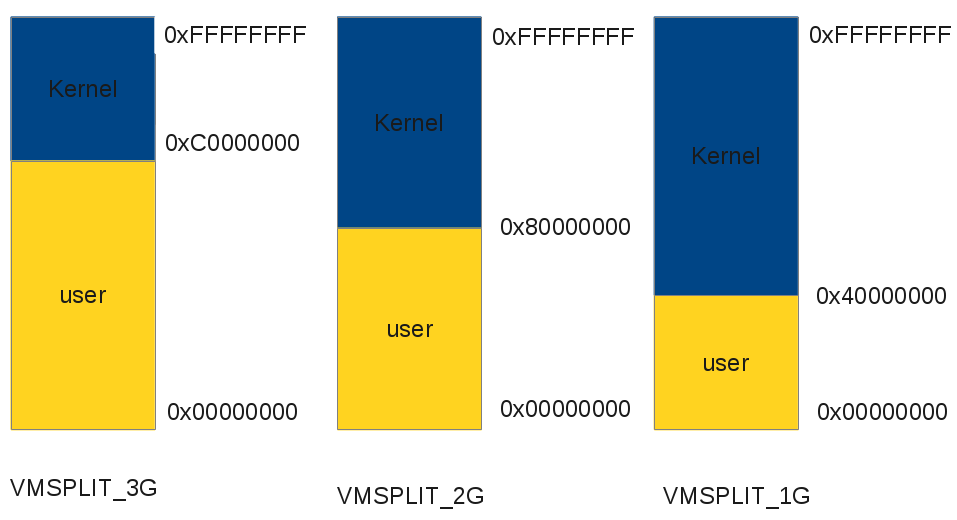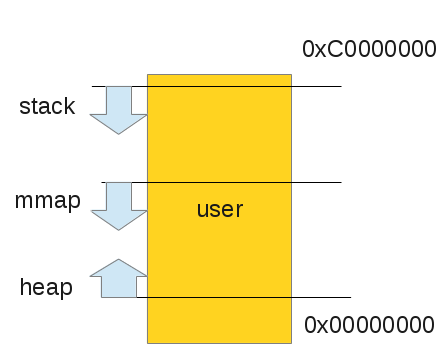http://thinkiii.blogspot.jp/2014/02/arm32-linux-kernel-virtual-address-space.html
The 32-bit ARM CPU can address up to 2^32 = 4GB address*. It's not big enough in present days, since the size of available DRAM on computing devices is growing fast and the memory usage of application is growing as well.
In Linux kernel implementation, user space and kernel must coexist in the same 4GB virtual address space. It means both user space and kernel can use less than 4GB virtual address space.
Linux kernel provides 3 different split of virtual address spaces: VMSPLIT_3G, VMSPLIT_2G, VMSPLIT_1G.
The default configuration is VMSPLIT_3G, as you can see, kernel space starts from 0xC0000000 to 0xFFFFFFFF and user space starts from 0x00000000 to 0xC0000000.
Let's take a closer look of the VMSPLIT_3G mapping:
vmalloc: The vmalloc memory is only virtually contiguous.
fixmap/pkmap: create fast mapping of a single page for kernel. Most used in file system.
modules: The virtual address for module loading and executing. kernel modules are loaded into this part of virtual memory.
In Linux kernel implementation, user space and kernel must coexist in the same 4GB virtual address space. It means both user space and kernel can use less than 4GB virtual address space.
Linux kernel provides 3 different split of virtual address spaces: VMSPLIT_3G, VMSPLIT_2G, VMSPLIT_1G.

|
| Linux virtual address space options |
The default configuration is VMSPLIT_3G, as you can see, kernel space starts from 0xC0000000 to 0xFFFFFFFF and user space starts from 0x00000000 to 0xC0000000.
Let's take a closer look of the VMSPLIT_3G mapping:
kernel space
We can observe the kernel virtual address by checking the boot log (dmesg) or take a look at arch/arm/mm/init.c.
lowmem: The memory that have 1-to-1 mapping between virtual and physical address. It means the virtual and physical address are both configuous, and this good property makes the virtual to physical address translation very easy. If we have a virtual address from lowmem, we can find out its physical address by simple shift. (see __pa() and __va()).
vmalloc: The vmalloc memory is only virtually contiguous.
fixmap/pkmap: create fast mapping of a single page for kernel. Most used in file system.
modules: The virtual address for module loading and executing. kernel modules are loaded into this part of virtual memory.
user space
The code for deterring user space virtual address is in arch/arm/mm/mmap.c
The user space have two different kind of mmap layout: legacy and non-legacy. Legacy layout sets the base of mmap(TASK_UNMAPPED_BASE) and the mmap grows in bottom-up manner; on the other case, non-legacy set the mmap base from TASK_SIZE - 128MB with some random shift for security reasons).The code for deterring user space virtual address is in arch/arm/mm/mmap.c
|
1
2
3
4
5
6
7
8
9
10
11
12
13
14
15
|
void arch_pick_mmap_layout(struct mm_struct *mm){ unsigned long random_factor = 0UL; /* 8 bits of randomness in 20 address space bits */ if ((current->flags & PF_RANDOMIZE) && !(current->personality & ADDR_NO_RANDOMIZE)) random_factor = (get_random_int() % (1 << 8)) << PAGE_SHIFT; if (mmap_is_legacy()) { mm->mmap_base = TASK_UNMAPPED_BASE + random_factor; mm->get_unmapped_area = arch_get_unmapped_area; } else { mm->mmap_base = mmap_base(random_factor); mm->get_unmapped_area = arch_get_unmapped_area_topdown; } |
The user space virtual address layout looks like:

|
| 32-bit user virtual address space layout |
*ARM has LPAE (Large Physical Address Extension) mode that can address up to 1TB.